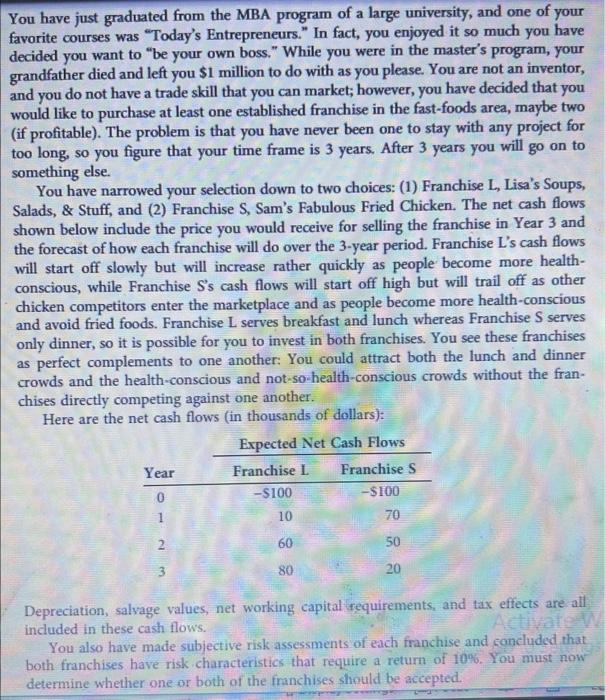You have just graduated from the MBA program of a large university, and one of your favorite courses was "Today's Entrepreneurs." In fact, you enjoyed it so much you have decided you want to "be your own boss." While you were in the master's program, your grandfather died and left you $1 million to do with as you please. You are not an inventor, and you do not have a trade skill that you can market; however, you have decided that you would like to purchase at least one established franchise in the fast-foods area, maybe two (if profitable). The problem is that you have never been one to stay with any project for too long, so you figure that your time frame is 3 years. After 3 years you will go on to something else. You have narrowed your selection down to two choices: (1) Franchise L, Lisa's Soups, Salads, \& Stuff, and (2) Franchise S, Sam's Fabulous Fried Chicken. The net cash flows shown below include the price you would receive for selling the franchise in Year 3 and the forecast of how each franchise will do over the 3-year period. Franchise L's cash flows will start off slowly but will increase rather quickly as people become more healthconscious, while Franchise S's cash flows will start off high but will trail off as other chicken competitors enter the marketplace and as people become more health-conscious and avoid fried foods. Franchise L serves breakfast and lunch whereas Franchise S serves only dinner, so it is possible for you to invest in both franchises. You see these franchises as perfect complements to one another: You could attract both the lunch and dinner crowds and the health-conscious and not-so-health-conscious crowds without the franchises directly competing against one another. Here are the net cash flows (in thousands of dollars): Depreciation, salvage values, net working capital requirements, and tax effects are all included in these cash flows. You also have made subjective risk assessments of each franchise and concluded that both franchises have risk characteristics that require a return of 10%. You must now determine whether one or both of the franchises should be accepted. d. (1) Define the term internal rate of return (IRR). What is each franchise's IRR? (2) How is the IRR on a project related to the YTM on a bond? M. May not be copied, scanned, or daplicated, in whole or in part. Doe to electronic rights, some third party coetent may be suppressed from the eBook and s moe maserially affiect the overall learning experience. Cengage leaming reverves the right so remove additioeal conteat at any time if subsequeet righis re Part 4 Projects and Their Valuation (3) What is the logic behind the IRR method? According to IRR, which franchises should be accepted if they are independent? Mutually exclusive








